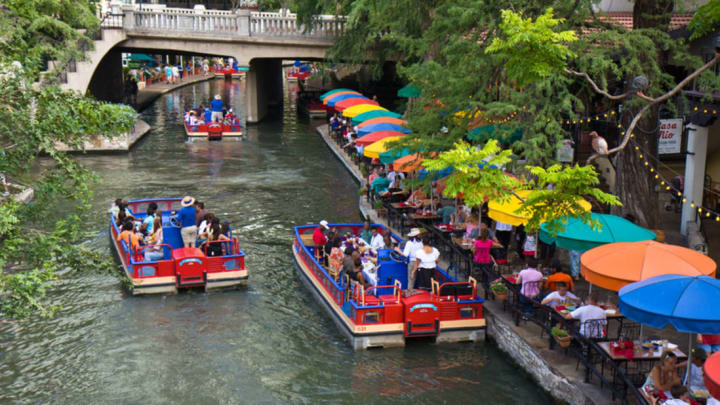8 Refreshing Facts About the San Antonio River Walk

Built along the San Antonio River, the River Walk in Texas’ second-largest city has been called the “American Venice.” Lined with bars, restaurants, biking trails, and museums, the Walk has become one of the most popular tourist spots in the state and is one of America’s largest urban ecosystems.
1. THE RIVER WALK GREW OUT OF A DEADLY FLOOD.
San Antonio was discovered by Spanish explorers and missionaries in the late 17th century and named in honor of Saint Anthony of Padua. The Spanish first settled in 1718 along the river, which had accommodated generations of indigenous Payaya who referred to the body of water as the yanaguana, or "refreshing waters."
By the early 20th century the city’s population had grown to over 160,000, and worries over potential flooding were realized during a 1921 hurricane that pummeled the area with high winds and nearly 14 inches of rain, causing the river to crest and flooding 1000 acres of land. There was millions of dollars in damage and over 50 people perished, and although there had been debate for years on what to do with the riverfront, this flood finally prompted the city to enact flood control measures and clean up the river, and led to the first iteration of a river-adjacent pedestrian walkway.
2. EARLY PLANS WOULD HAVE ELIMINATED THE WATER.
The San Antonio Conservation Society was formed in 1924 and sought measures to control flooding and save iconic buildings, but a proposal to drain the river, direct it underground, and build city streets atop a storm sewer was opposed. A local architect, Robert H.H. Hugman, designed a new flood control plan and a walkway called the Shops of Aragon and Romula that was reminiscent of Old Spain.
3. THE DEPRESSION (AND WWII) DELAYED THE PROJECT.
Although a bypass channel was completed in 1929 at the beginning of the project, the October 29 stock market crash forced developers to halt any further work. Nine years later, the Works Progress Administration revived the plan with $325,000 in funding. Hugman was hired, and the River Beautification Project began construction in early 1939. Hugman was let go the following year, and although the project was officially completed on March 14, 1941, the full extent of Hugman’s vision wasn’t implemented due to the outbreak of the second World War.
4. DISNEYLAND DESIGNERS HELPED REVITALIZE THE PROJECT.
Years of lackluster development along the river led to the creation in the late 1950s and early '60s of the Tourist Attraction Committee, River Walk District, and the River Walk Advisory Commission. In 1961, the California-based Marco Engineering Firm, led by developer C.V. Wood, Jr., completed a report funded by the San Antonio Chamber of Commerce to look into the commercial prospects of the retail space along the river. Wood, who helped create Disneyland and other theme parks throughout America, suggested a Mexican colonial theme for the development, along with a merchants’ association and multiple festivals to be held in the area.
5. THE RIVER WALK SPANS MORE THAN 15 MILES.
On the 250th anniversary of San Antonio’s founding, the 1968 World’s Fair, called HemisFair, was held in the city from April through October. In preparation, a ¼-mile addition of the River Walk had been completed, which extended the walk to the convention center via a lagoon. In 2009, a new section of the River Walk called the Museum Reach was completed, adding 1.3 miles of trails and walkways.
To the south, the Mission Reach Ecosystem Restoration and Recreation Project was finalized in 2011 and added eight additional miles. Multiple entities chipped in $384.1 million for the San Antonio River Improvements Project, lengthening the River Walk to 15.5 miles.
6. THE RIVER USED TO DISAPPEAR NEARLY EVERY YEAR.
Although yearly maintenance has been eschewed for partial cleanups, in January swaths of the San Antonio River downtown were emptied to clean the lock and dam near Brooklyn Street and remove debris from the river. In addition, sediment was removed from the river to improve the water quality; in 2010 and ’11 nearly 9 tons of sediment were stripped from the river. The process of draining and refilling the river, which can be as shallow as two to three feet downtown, takes about six days. The next full draining is scheduled for 2020.
7. LOCAL RESIDENTS CELEBRATED THE RIVER'S MUCK.
Not ones to let an opportunity for a party pass them by, citizens of San Antonio relished the annual draining of the river by throwing a Mud Festival. The events included a Mud Pie Ball, Mud Parade, and Mud Coronation, complete with a Mud King and Queen. Although thousands of visitors descended to the river for the January parties, the newly clean river has seemingly put a stop to the Mud Festival for now.
8. IT IS A POPULAR WEDDING LOCATION.
The planting of a cypress tree along the river 100 years ago created a small promontory that has become known as Wedding Island. Located in front of Hotel Contessa, the site of the tree is allegedly where Father Damian Massanet conducted a Catholic Mass in 1691, and local artist Rolando Briseño was commissioned in 1991 to create a sculpture that honored the original Mass. The city charges $200 for a 30-minute ceremony, and there are about 225 weddings held on the site every year.